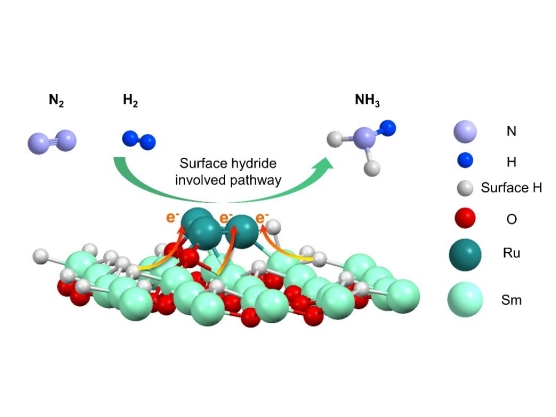
Recently, our group, in collaboration with Associate Professor Wu Anan from Xiamen University, has made new progress in the research of catalytic ammonia synthesis. We discovered in situ generated samarium hydrogen (Sm‒H) species on the surface of samarium oxide-supported ruthenium clusters (Ru clusters/ Sm2O3) ammonia synthesis catalysts and revealed their catalytic mechanism of participation in the ammonia synthesis process.
Ammonia is an important chemical raw material and also a hydrogen energy carrier with application prospects. The transformation and upgrading of the synthetic ammonia industry under the background of "double carbon (carbon peak, carbon neutrality)" and the development needs of green synthetic ammonia technology based on renewable energy have put forward higher requirements on the performance of synthetic ammonia catalysts. In this work, the research team successfully prepared a new Ru clusters/ Sm2O3 synthetic ammonia catalyst using rare earth oxide Sm2O3 as a carrier. The study found that the catalyst exhibited high catalytic activity, good stability, sintering resistance and water impurity tolerance under mild reaction conditions, showing good application prospects. Experimental and theoretical calculations show that the catalytic activity of Ru clusters/ Sm2O3 is closely related to the formation of hydrogen species on the catalyst surface. The Sm‒H species generated in situ on the surface of the carrier under reaction conditions can not only effectively increase the surface electron density of the ruthenium clusters, but also promote the activation and dissociation of N2 molecules on the ruthenium clusters. More importantly, Sm-H species, as an active hydrogen species, can directly participate in the generation of NH3 during the reaction process, significantly improving the catalytic activity of the Ru clusters/ Sm2O3 catalyst.
This work not only explains at the molecular level the difference in catalytic mechanism between the active centers composed of hydrogen species and ruthenium clusters on the surface of rare earth oxides and the B5 site on conventional ruthenium catalysts, but also provides ideas for the design and preparation of practical ammonia synthesis catalysts under mild conditions. The results of this study were recently published in ACS Catalysis under the title "Synergizing Surface Hydride Species and Ru Clusters on Sm2O3 for Efficient Ammonia Synthesis". The first author of this work is Zhang Xilun, a doctoral student in our group. This research work was supported by the National Natural Science Foundation of China, the Basic Science Center Project of the National Natural Science Foundation of China" Air Main Component Conversion Chemistry", and other projects. (Text/Photo byZhang Xilun, Liu Lin).
Article link: https://doi.org/10.1021/acscatal.1c05985

 Home
>>
Highlights
Home
>>
Highlights